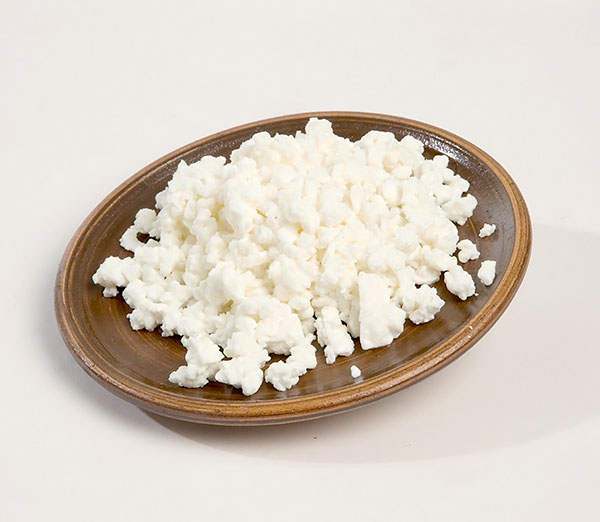milk | butter | kefir | cheese | yogurt | sour cream | buttermilk | sour milk | cottage cheese | curd | pudding
 Cottage Cheese – a Cheese or a Curd?
Cottage Cheese – a Cheese or a Curd?
The question about cottage cheese is this: is it a cheese or a curd? Although it looks more like curd, its production process resembles that of cheeses.
Main Nutrients in Cottage Cheese
All cottage cheeses are soft and contain a lot of water – their moisture content is up to almost 80%. The remaining one fifth consists of dry matter. If this product is stored over a long period of time, for example in a plastic bag or a cup, some of the water may drain out of it and form a layer underneath.
At the same time, the high water content of cottage cheese is not permanent – if the product is kept in an open package for a long period the surface layer dries out very quickly. This brings about partial changes in its structure, colour and flavour as well.
The first group of macronutrients in cottage cheese is fats. The diversification of cottage cheeses started with altering the fat content in the product, and the consumer had a choice between products with minimum, medium or high fat content. It is no secret that the fat content of cottage cheese is often increased at home by adding sour cream before eating.
Today we can buy the so-called fat-free cottage cheese (contains up to 0.1% of fat) and the classical product – cottage cheese with 4% fat content. The fat content of cottage cheese may be as high as 6%. Unfortunately, cottage cheese with a low fat content is rather dull to the palate and also dryish, as fats give the food its usual softness and characteristic taste.
People are however resourceful, so fat-free cottage cheese is even mixed with mineral water to make it tastier. It’s good to know that various added ingredients will generally increase the fat content of cottage cheese, but the increase is not great.
The second group of macronutrients in cottage cheese is carbohydrates. In the manufacturing process most of the milk sugar of the product remains in the whey, and some of it is used as food by the microbes in the starter. Therefore, natural cottage cheese is a product with a lower milk sugar (lactose) content and it can be recommended to people who cannot consume fresh milk due to lactose intolerance.
The lactose content of natural cottage cheese without any additional ingredients is around 2–3%. The same rule applies here as well that additives both increase the general carbohydrate content of cottage cheeses and diversify their composition. Jam as an ingredient makes a big contribution.
The third group of macronutrients in cottage cheese is proteins. The biological value of cottage cheese as a food product is increased by its relatively high protein content – that is around 14–18% in genuine cottage cheeses. It is also important that milk proteins have amino acids in an appropriate composition for the human organism, so are digested easily.
During the manufacturing of cottage cheese the bacteria of the starter, rennet and the acidic environment affect the proteins in such a way that makes them even more digestible. Regarding flavoured products containing various ingredients, their protein content is somewhat lower compared with the protein content of natural cottage cheese.
There is also a correlation between the fat and protein content – fattier cottage cheeses contain less proteins and the products with a lower fat content contain more. You should keep in mind that a 100-gram portion of cottage cheese with medium fat content satisfies around 18–25% of the recommended dietary allowance of proteins, and that these are high quality food proteins. In general, natural cottage cheese with a medium fat content (4%) without any additional ingredients is not a very energy-rich food – a 100-gram portion of it gives the consumer around 100 calories of food energy.
You should also take into account that various ingredients change the calorific value of the product. They increase the energy value to a certain extent, but there are also some that do the opposite. With additional ingredients, the increase-decrease of the calorific value of the product is usually around 20 calories per 100-gram portion.
Their fear of calories is the reason why people prone to overweight prefer fat-free cottage cheese in their menu, but the prolonged use of the latter may bring about problems with the assimilation of certain types of micronutrients in the gastrointestinal tract.
Micronutrients in Cottage Cheese
Natural cottage cheese is often praised for its rich calcium content. This is not wrong, but we should also point out that, compared with liquid dairy products, cottage cheese contains much less calcium as a considerable amount of it remains in the whey that is drained out of the product.
Cottage cheese is still a very good source of calcium though, especially when it is eaten often and in large quantities. The calcium-phosphorus ratio in cottage cheese also fosters the assimilation of these elements in the gastrointestinal tract. Speaking about the mineral composition of cottage cheese we shouldn’t forget table salt or sodium chloride.
To tell the truth, producers do not add much salt to the product, so the ordinary product contains only 0.8–1% of table salt. Products with additional ingredients can contain somewhat more. A healthy way of flavouring cottage cheese is to replace ordinary table salt with one of those where part of the sodium chloride has been replaced by potassium and magnesium salts.
It’s also good to know that no preservatives are added to natural cottage cheeses. This results in their shorter shelf-life and in a requirement to store them at a cold temperature of 2–6 oC. On the other hand, various additional ingredients in cottage cheese may contain preservatives and additives, so you should always check the product label for additional information.
Additional Ingredients Give an Appearance to Cottage Cheese
Today, product development is booming among cottage cheeses as well, as additional ingredients are the easiest way of attracting the attention of consumers. These products provide several benefits for the eater.
Firstly they save time. Cottage cheese is a popular component in salads. So instead of buying all those ingredients separately and combining them at home this work is done by the manufacturer.
Secondly, well-chosen and well-combined ingredients diversify the biochemical composition and the nutritional value of cottage cheese.
Thirdly, the more products with various ingredients and flavours the larger should be the circle of cottage cheese friends and lovers.
Most of the additional ingredients are vegetarian. This product line includes products with herbs and condiments (garlic, horse-radish, onion, dill, parsley, mustard), tomatoes, cucumber, bell peppers and even products with cloudberry jam. The vegetarian component serves several purposes. Cottage cheese softens the bitter taste of herbs but the final product preserves all the useful vegetarian components.
It is also important that in combined food products the vegetarian components increase the content of useful micronutrients. Cottage cheeses with vegetarian components contain more potassium compounds, vitamin C, carotenoids, bioflavonoids and phytoncides. If there are plenty of vegetarian ingredients in cottage cheese, its fibre content increases as well. And there is more – the vegetarian component in a white-coloured cottage cheese is also beautiful to the eye.
The second group comprises ingredients of animal origin. There are cottage cheeses flavoured with seafood sticks and tuna on sale in the stores. The fish proteins from these ingredients enrich the biological composition of the proteins and fats of the product and increase its respective nutrient content.
The representatives of the third group belong to the fungus kingdom. For example, cottage cheese enriched with button mushrooms is widely offered for sale. In principle it is possible to manufacture cottage cheese with a mouldripened cheese ingredient as well. Well, in this case, the additional ingredient mostly consists of cheese, not of the mould fungi. The value of the mushroom component is that it increases both the fibre content and the quantity of extractive substances that stimulate digestion.
The fourth group consists of dairy products. Just as many people like to add milk, fresh cream, yogurt or sour cream to cottage cheese, the same ingredients are added to commercially produced cottage cheeses as well to improve and diversify the flavour of the product. On the one hand adding fresh or sour cream to the product increases its general calorific value; adding fat-free milk or natural yogurt, on the other hand, decreases it.
In the latter case, the reduction of the overall fat content is the key word. When you study product labels carefully you can see that the quantity of added ingredients can vary a lot, and that it usually depends on the nature of the flavouring ingredient. It is possible to add spicy herbs in much smaller quantities than seafood sticks, tuna, cheese or jam.
Another group of food products consists of salad-like products where cottage cheese is combined with vegetarian components – the so-called gourmet salads. In this case the product is not cottage cheese any longer but a mixed salad based on cottage cheese. Added value, of course, increases the price of the product but its ease of use and time-saving elements are something worth paying for.
Cottage cheese with probiotic bacteria is an entirely different product. This is the so-called functional cottage cheese that has all the advantages of an ordinary cottage cheese and in addition the new and healthy added value. Namely, when you eat these bacteria they enrich the microbiological habitat of the intestines, they produce some vitamins, and have other beneficial effects on the gastrointestinal tract that are good for the health of the human body.
Applications of Cottage Cheese
Years ago, natural cottage cheese was eaten as a dish on its own or in mixed salads with herbs. Today, the picture has changed a lot. Cottage cheese is consumed more and more both in savoury dishes and desserts, both in cold and warm food.
Cottage cheese is successfully used in salads, baked dishes, on sandwiches, in pastry fillings and omelettes, in salad dressings and pastry. Cottage cheese can be successfully combined with fish, meat, eggs, prawns, pasta, cheese, vegetables and mushrooms. Amongst others, cheese cakes, tarts, pancakes and other desserts with cottage cheese are very popular today.
See recipes using cottage cheese
Share ►


